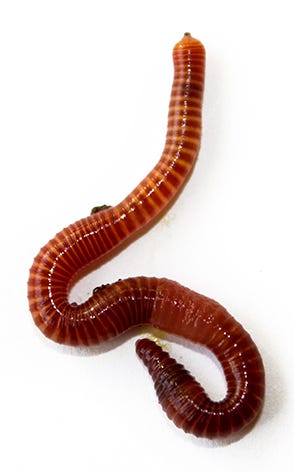Get Red Wiggler Worms - Suitable for Composting and Horticulture
Get Red Wiggler Worms - Suitable for Composting and Horticulture
Blog Article
Red Wiggler Worms Demystified: Unlocking the Tricks of Vermiculture for Greener Living and Nutrient-Rich Soil
In the world of sustainable practices for enhancing soil top quality and advertising eco-conscious living, red wiggler worms play a pivotal yet frequently overlooked role. Red Wiggler Worms. Recognizing the complexities of caring for these worms, enhancing their setting, and utilizing their castings can lead to a greener way of living and healthier dirt for plants to flourish.
The Role of Red Wiggler Worms
Red Wiggler worms play an important duty in composting systems by successfully damaging down raw material into nutrient-rich castings. These ravenous eaters take in a variety of organic products, such as kitchen scraps, lawn waste, and paper items. As they feed, the worms' digestive system processes damage down the raw material into a penalty, dark, and nutrient-dense product called worm spreadings or vermicompost.
The spreadings generated by Red Wiggler worms are highly valuable for soil health and plant development. They are rich in crucial nutrients like potassium, nitrogen, and phosphorus, which are vital for supporting healthy plant development. Additionally, worm castings consist of helpful germs and enzymes that help improve dirt structure, increase water retention, and enhance nutrient uptake by plants.
Benefits of Vermicomposting

Furthermore, vermicompost, the nutrient-rich final product of vermicomposting, functions as an outstanding organic plant food and soil conditioner. It improves dirt framework, boosts soil aeration, and enhances dirt wetness retention. These buildings contribute to much healthier plants with stronger origin systems and much better resistance to parasites and illness. Vermicompost additionally enriches the soil with essential nutrients like potassium, nitrogen, and phosphorus, promoting plant development and overall soil fertility.
Additionally, vermicomposting supports sustainable horticulture techniques by giving a natural and chemical-free option to artificial plant foods. Red Wiggler Worms. This eco pleasant technique not just improves the dirt yet additionally helps in reducing reliance on dangerous chemicals, advertising a greener and a lot more lasting means of horticulture
Establishing a Worm Container
When establishing a worm bin for vermicomposting, proper arrangement is important to make sure the success of the composting process. The first action in establishing up a worm container is choosing a suitable container.
After including the bed linens, introduce the red wiggler worms to the bin. It is advised to begin with a handful of worms and gradually raise as they increase. The worms ought to then be provided with food scraps such as vegetables and fruit peels, coffee grounds, and eggshells. It is vital to stay clear of adding meat, dairy products, oily, or salty foods to stop bring in bugs and creating undesirable odors.
Consistently check the wetness levels and temperature level in the worm bin to make certain ideal conditions for the worms. With correct configuration and upkeep, the worm bin will properly convert organic waste into nutrient-rich garden compost for your plants and garden.
Collecting Worm Castings
To effectively gather nutrient-rich worm castings from your vermicomposting system, an organized harvesting method is essential. When it comes time to basics gather the worm spreadings, there are a few crucial actions to follow to ensure an effective process. Quit adding fresh food scraps to one side of the worm bin for a pair of weeks before harvesting. This urges the worms to move to the side with fresh bedding and food, making it simpler to scoop out the spreadings from the opposite side.

Troubleshooting Common Issues
Identifying and addressing typical challenges that might occur during the vermicomposting procedure is important for maintaining a effective and healthy worm container. Adding excess food scraps can lead to a build-up of wetness and level of acidity in the worm bin, possibly hurting the worms. An additional problem is unpleasant smells emanating from the worm container.
Additionally, if the worm populace is decreasing or the worms appear unhealthy, it can be due to ecological stressors such as severe temperatures or pH degrees. Checking these factors and making essential adjustments is crucial for the well-being Recommended Site of the worms. By repairing these common problems without delay, vermicomposters can make sure a smooth and successful vermicomposting procedure while keeping a growing worm population.

Conclusion
Finally, red wiggler worms play a critical duty in vermiculture by damaging down natural issue right into nutrient-rich dirt. The advantages of vermiculture include greener living and improved soil high quality. Establishing a worm bin is vital for successful vermiculture, and harvesting worm castings provides important garden compost for horticulture. By recognizing and repairing typical problems, individuals can open the keys of vermiculture for sustainable living and much healthier dirt.
As they feed, the worms' gastrointestinal processes damage down the natural matter into a penalty, dark, and nutrient-dense product recognized as worm castings or vermicompost.
The spreadings created by Red Wiggler worms are highly advantageous for dirt health and wellness and plant growth. Adding excess food scraps can lead to a build-up of wetness and level of acidity in the worm container, potentially damaging the worms.Additionally, if the worm populace is decreasing or the worms appear unhealthy, it can be due to environmental stress factors such as extreme temperature levels or pH degrees. Establishing up a worm bin is vital for effective vermiculture, and gathering worm castings gives useful compost for horticulture.
Report this page